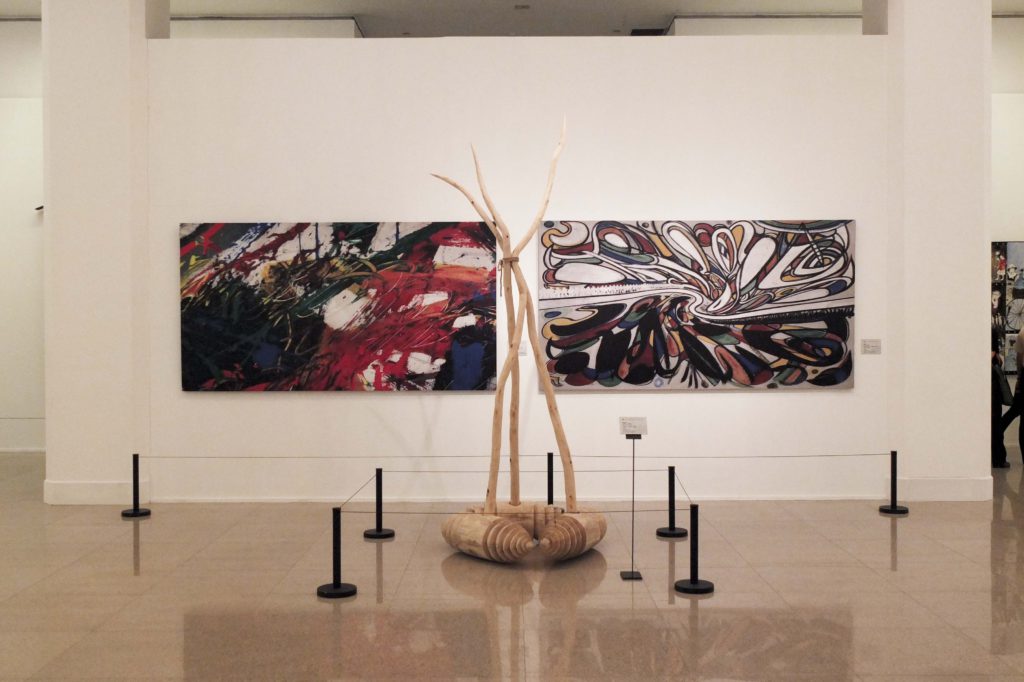Hagop Sulahian: architect by day, artist by night, and social servant around the clock
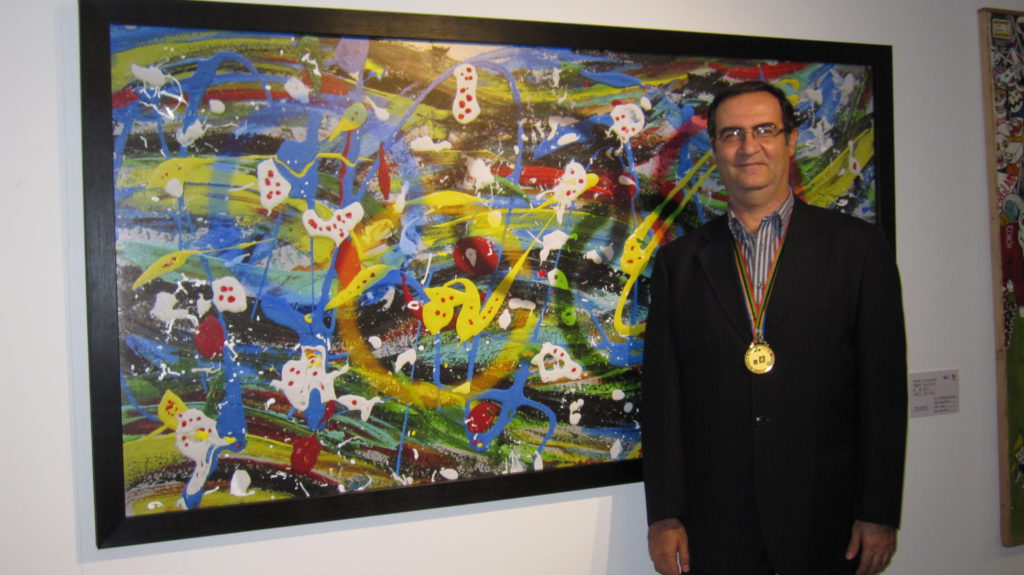
Arleb by Nabad interviews co-founder of MEADOWS NGO Hagop Sulahian, who presents himself as “architect by day, artist by night, and social servant around the clock”. Sulahian talks about his work at the crossroads of art and architecture and explains the roles and impact of city embellishment and art therapy in Lebanon.
Arleb by Nabad – Tell us more about you…
Hagop Sulahian – All these functions make up the entirety of my personal and public life. Naturally, a good part of these activities are conducted jointly with my better half, my partner in every activity, I meant by that my wife Lena Kelekian the artist and exceptional human being. Having studied architecture at AUB (Graduated 1984) and been practicing it for the past 37 years with different architectural consultation firms and later on independently through my own company and practice has provided me with substantial experience and know-how in the fields of design and construction which I had followed up later on with advanced studies in the restoration of heritage buildings in Spain & Portugal. Being active for over twenty years in my youth in the scouting movement provided the foundation for public service which led me to become a founding member of MEADOWS NGO with Lena and provide service of a different kind at a different level. My introduction to the world of art came through her as well, as she was the one to encourage me to exhibit the scarce art pieces that I rarely had the time to paint. The more I spent time with her at the art studio the more I got entangled in the art world and its charm and the more I became face to face with the challenge of balancing Art with Architecture. Although both are in a way complementary and one can hardly exist without the other but what I am emphasizing is about being able to establish a balancing act within me between the architect and the artist that I ended up being. The more one was pushed to the foreground the more I felt the other was being subdued but I feel blessed to have them both as I have become as passionate about art and art-related activities as much as I have been about architecture all my life. Especially after gearing an important section of our joint business in art-related activities, namely city embellishment, and artistic curatorial work. After following jointly with Lena specialized curatorial studies for the setting up of exhibitions and displays for exhibitions in museums at the Beijing Academy of Arts affiliated with Beijing University in 2014 and we have been very active in that domain ever since through our MEADOWS NGO organizing major international exhibitions with a large number of participants representing a wide array of countries. My participation in an immense number of collective exhibitions in dozens of countries around the world and having around a dozen of my private exhibitions — and after earning the Olympic Fine Arts gold medal at the 2012 London Olympics — catapulted me into the art world through a wide gateway which brought acknowledgment and many other trophies and awards in the field of the arts.
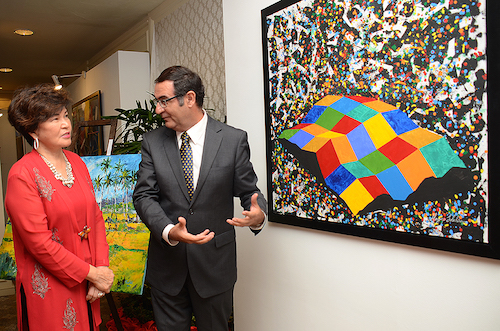
Arleb by Nabad – What is city embellishment?
Hagop Sulahian – It is a term that we have adopted for a wide range of activities that we have bundled up under that heading. I believe that probably other people had been doing some sort of related activities in the past but I think we are the very first in Lebanon to create a niche that is entirely dedicated to activities that are all interrelated, complementary, and sustainable in nature at the same time. A clear definition of city embellishment in my words would be: “the creation of landmarks of artistic nature that give identity and character to any location”. These landmarks could be mostly outdoors but also could be indoors. There are many tools and materials that could be deployed for this purpose, mostly identified under “hard landscaping”. The venues are mostly public spaces with maximum exposure. Like sidewalks on waterfront corniches for example the “Embellishment project of the Ain Mreiseh corniche waterfront – Avenue De Paris” the embellishment of the entire length of the 2.5 km stretch from the former “Artisanat” building all the way to the new lighthouse with 76 colorful ceramic clad cement benches that serve the purpose of “functional art”. Being artistic pieces, with a unique design for every bench as well as functional, serving as benches and entertaining by having a chessboard encrusted on each one of them providing the possibility for people to play chess or similar games on the benches. The jewel of this project is the 8m x 8m large Mega-chess that was installed on the widest segment of the sidewalk that was created using over 22 different hues of ceramics.
Other examples are murals whether situated along roads, be it retaining walls like the 60 m long mural along the coastal road leading from Beirut to the north behind “Forum the Beirut” or at the entrance or exit of tunnels like the “Salim Salam tunnel” (under construction) or within tunnels like the Sassine tunnel in Ashrafieh (Lena receiving 1st prize for her design for that international competition in 1997) or along embankments like the Beirut river wall mural of 500 m length in the direction of Nabaa. Also within private projects like the Kempinsky – Summerland resort marina mural stretching over 220 linear meters or the beach mural of over 65 linear meters and the eight beach bungalow murals. Likewise, monuments constitute an important element of city embellishment where it is mostly abstract designs covered again with colorful ceramic pieces technique like the 5m monument of coexistence in the Burj Hamoud municipal square or the 9 m conical monument in front of the north coastal road mural or the 15 m high monument at the entrance of Aley city along the Beirut Damascus highway or the monument carrying the emblem of Haigazian university at the corner of main Hamra road and the monument commemorating the Armenian Genocide within the garden of the “Mugar” building in Haigazian University. Also, murals within leftover plots were transformed into public gardens in the Nabaa, Ashrafieh, and Burj Hamoud neighborhoods.
An example of indoor city embellishment would be artwork furnishings of corporate buildings or institutions like hospitals and clinics like all buildings of CMC, Clemenceau Medical Center affiliated with Johns Hopkins USA in Beirut, Dubai and in Riyadh, the Belleview Medical center, Hotel Dieu de France, the Kempinsky Hotel Royal suites, etc.

Salim Salam Tunnel 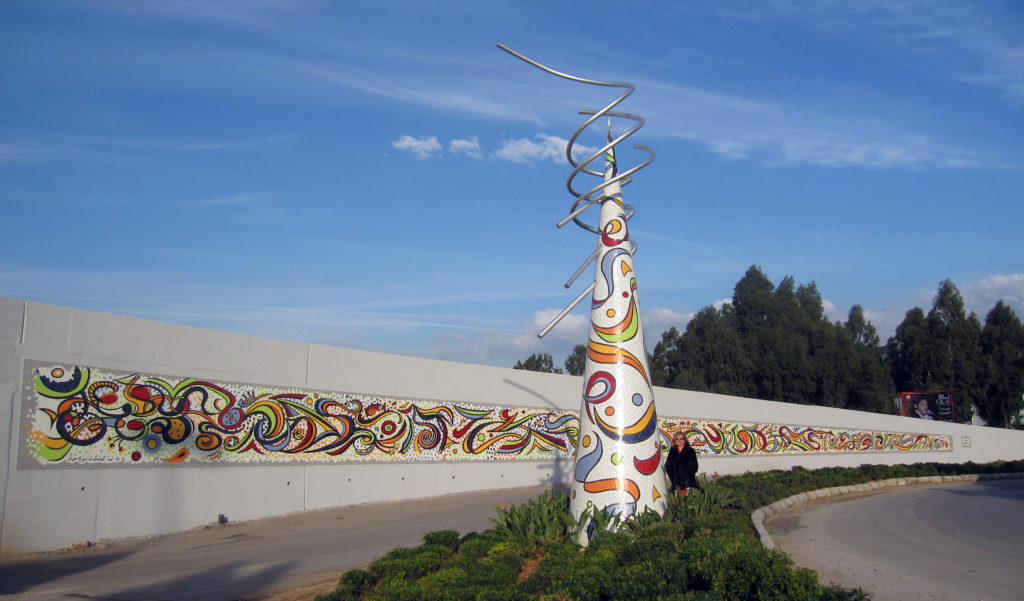
Coastal Road Monument and Mural 
Corniche Benches
Arleb by Nabad – What about Meadows NGO and its role in city embellishment? And what is the relation between city embellishment and art therapy?
Hagop Sulahian – MEADOWS which is the acronym for Mediterranean Endeavors Advancing Development Of Widespread Sustainability was established in early 2000 but officially registered in 2007 and from its incipient beginnings, it has grown into an NGO with representations in over 86 countries creating a network of over one thousand artists worldwide. MEADOWS is headquartered in Beirut Lebanon and covers a plethora of activities from social to cultural to artistic. So this is where City Embellishment and MEADOWS overlap because realizing large-scale projects is far more accessible through a credible NGO than through an individual and international or local donors are more inclined to work with NGO’s that have a clear declared goal and transparent track record than working with individuals.
There is a very interesting correlation between City Embellishment and Art Therapy which is classified as “community therapy” where the designed spaces that are embellished with beautiful colorful designs that induce positivity and good mental health in an indirect manner where the masses are exposed to all these cleverly designed landmarks and influenced by them. This is where art in public spaces plays an instrumental role.
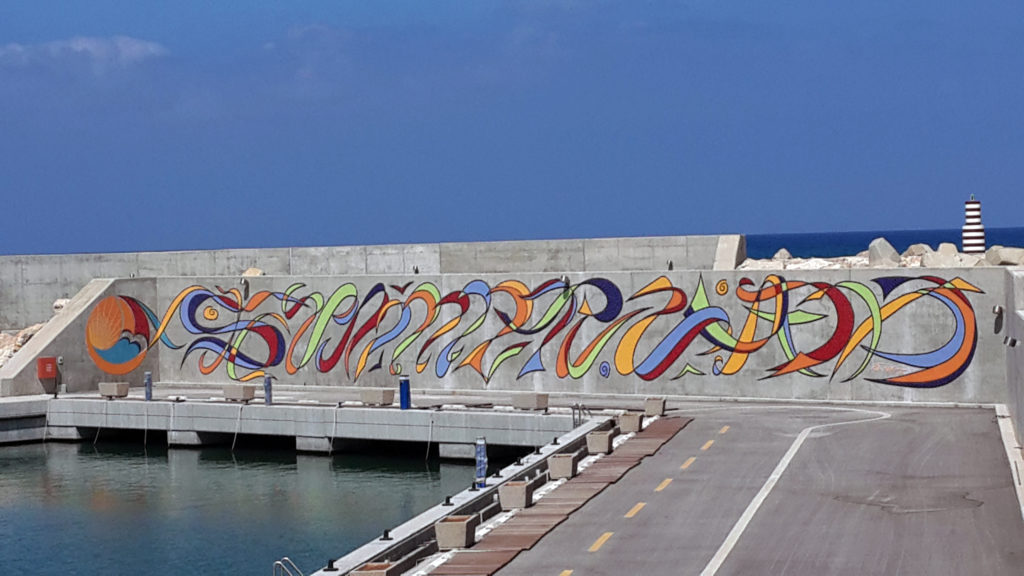
Kempinski Summerland Marina 
Beirut River Bank Mural
Arleb by Nabad – What are, according to you, the main challenges/obstacles facing architects and architecture nowadays in Lebanon?
Hagop Sulahian –The many challenges and inadvertently obstacles facing architects did not commence nowadays but actually goes back to a few years now. The reasons are manyfold. The first is the large number of graduates which a healthy “normal” construction market could not easily accommodate, secondly the drop in numbers of graduates that were hired outside Lebanon (mostly in Gulf countries) due to the availability of much cheaper alternatives coming from countries like India, Philippines, etc. moreover the economic crisis and to top it all the COVID 19 pandemic. The problem with the practice of architecture is also that it is very precarious for a fresh graduate to start his own personal practice. First, he needs at least 3 years of working experience in a credible firm and secondly, an inexperienced architect can easily endanger his business and the interests of his clients if he lacks the experience & necessary know-how of how to manage a project. As it is not just about designing an attractive design, that is only the tip of the iceberg. There is so much more to creativity and it all boils down to cost-effectiveness and good management.
Arleb by Nabad – What are, according to you, the roles of architects and architecture in social, economic, environmental, or political change?
Hagop Sulahian – It has been an irrefutable fact that many individuals in prominent leading positions (whether their impact was positive or negative) came from architectural backgrounds. This is because architecture is all about being disciplined in your work be it design or thinking methodology or organization of state affairs. That is why most architects are quite successful in organizational tasks. The relevance of good architecture — and its positive implications to the social, economic, and environmental aspects — is an established fact and we have been applying those methodologies through our MEADOWS NGO in creating child-friendly and public friendly environments such as playgrounds, public spaces, roundabouts sidewalks, parks, etc. It is well known that any neighborhood which has an architectural design that incorporates those principles contributes positively to the reduction of tensions between the inhabitants and registers the lowest levels of aggressiveness and is conducive to a more friendly environment, in contrast to congested, ghetto-like designs that are deprived of all kind of public facilities for youngsters to fend off their steam and energy and adults to get immersed in green lush spaces. Obviously, the contentment or discontent of inhabitants can reflect directly at election polls in civilized countries where all running to public service positions are held accountable at the next election. Hoping that our Lebanese culture catches up with this aspect in the next elections if there is to be any hope of change and reform in the country.
